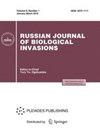MODELLING OF HERACLEUM SOSNOWSKYI MANDEN. AND HERACLEUM MANTEGAZZIANUM SOMMIER & LEVIER COENOPOPULATION AREA INCREASE RATE
IF 0.6
Q4 ECOLOGY
引用次数: 0
Abstract
On the basis of developed individual-based model and empirical data the importance of anemochory for the dispersal of giant hogweed mericarpia over long distances (up to 55 m from the parent plant) was proved. The use of cellular automate for modelling of the plant coenopopuation area increase allowed to reveal the influence of weather condition, number and spatial distribution of hogweed plants in the period of the beginning of introduction on the rate of invasion. Verification of the results of the cellular automaton work based on satellite images and field observations showed a significant level of compliance of theoretical calculations and observed results. The logistic functions parameters describing the change in the area of giant invasive hogweed stands were determined. A retrospective analysis of satellite images of model plots, starting from the 90s of the 20th century, showed an annual increase in the area of hogweed coenopopulations by 20% in the exponential population growth phase. A significant variability in the rate of invasion (from 5% to 70% per year) depended on the initial conditions and stage of invasion, usage modes and ecological capacity of the available sites.赫拉克利姆的建模。人口面积增长速度较快
基于已建立的基于个体的模型和经验数据,证明了风速对大猪草长距离(距离亲本植物55 m)传播的重要性。利用元胞自动化对植物种群面积增长进行建模,可以揭示引种初期天气条件、大猪草植物数量和空间分布对入侵率的影响。基于卫星图像和实地观测的元胞自动机工作结果的验证表明,理论计算和观测结果具有显著的一致性。确定了描述大猪草入侵林面积变化的logistic函数参数。从20世纪90年代开始对模型地块的卫星图像进行回顾性分析,结果显示,在人口指数增长阶段,猪草种群面积每年增长20%。根据入侵的初始条件和阶段、利用方式和可利用场地的生态能力,入侵率有显著的变化(每年5% ~ 70%)。
本文章由计算机程序翻译,如有差异,请以英文原文为准。
求助全文
约1分钟内获得全文
求助全文
来源期刊
CiteScore
1.20
自引率
14.30%
发文量
40
期刊介绍:
Russian Journal of Biological Invasions publishes original scientific papers dealing with biological invasions of alien species in both terrestrial and aquatic ecosystems and covers the following subjects:description of invasion process (theory, modeling, results of observations and experiments): invasion corridors, invasion vectors, invader species adaptations, vulnerability of aboriginal ecosystems;monitoring of invasion process (reports about findings of organisms out of the limits of natural range, propagule pressure assessment, settling dynamics, rates of naturalization);invasion risk assessment; genetic, evolutional, and ecological consequences of biological invasions of alien species; methods, means of hoarding, processing and presentation of applied research data (new developments, modeling, research results, databases) with factual and geoinformation system applications;use of the results of biological invasion research (methods and new basic results) under the study of marine, fresh-water and terrestrial species, populations, communities and ecosystems; control, rational use and eradication of the harmful alien species..

 求助内容:
求助内容: 应助结果提醒方式:
应助结果提醒方式:


